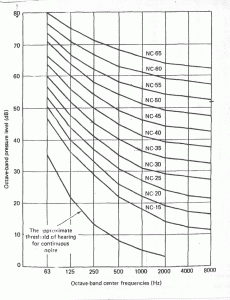Acoustics is the science that studies sounds in terms of production, transmission and effects.
In an architectural understanding , the main application of acoustics is the level of control we require in view of better sound quality, sound insulation/absorption and noise reduction from external sources. This is generally driven by geometry of the space, arrangement of the wall enclosing the room and finishes of the room.
The two most common concerns we come across in a room design is noise build up or echoing and transmission between two spaces. There comes the terms like NRC and STC into spotlight that assists in picking up right material for any given room design. Both the specifications are suggested on all the finish materials.
NRC or Noise Reduction Coefficient defines how much sound specific material absorbs that is represented in single number index. For example NRC of 0.9 will absorb 90% of the sound that comes into contact of it and balance 10% is reflected. Therefore, room finished with materials like carpet, fabric walls, glass wool ceiling or wall tiles are preferred in quieter spaces.
NRC of 0 complete reflection of sound and NRC of 1 is complete absorption of the sound.
STC or Sound Transmission Class defines how much a sound a wall/floor/ceiling would block the transmission from one space to another. Higher the rating, the more effective the material is at blocking the sound at the common frequencies i.e. 125 Hz – 4000Hz.
The STC rating of the wall is derived from complete arrangement of the wall that involves mass of the wall, air cavity and insulation infill. It is also very important for cutting external noise levels.
STC or NRC rating is carried out in a lab on a specific material that doesn’t address the things like joints, material junctions or any other such weak point. Therefor such losses should be taken into account. Both the specifications are independent of each other and it is the combination of both that works best for different functions.
To evaluate the acoustic performance of any given room, Noise Criteria (NC) or Noise Rating Curve (NR) is the standard that defines the relative loudness in a space with respect to range of frequencies. Each NC curve is defined by sound pressure level over the eight octave bands frequencies.
There are available standards for NC ratings for different spaces which are acceptable and followed in view of speech intelligibility . Below are some broad recommendations:
NC 20 – Concert halls, broadcast, recording studios, large auditoriums.
NC 20-30 – Auditoriums, theaters, large meeting rooms, courtrooms, boardrooms.
NC 25-35 – Bedrooms, hospitals, apartments, hotels
NC 30-35 – Private offices, small conference rooms, classrooms and libraries
NC 35-40 – Large offices, retail shop,s cafeterias, restaurants
NC 40-45 – Engineering rooms, maintenance rooms, hardware areas, canteens
NC 45-55 – Kitchens, laundry facilities
